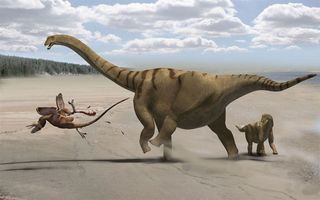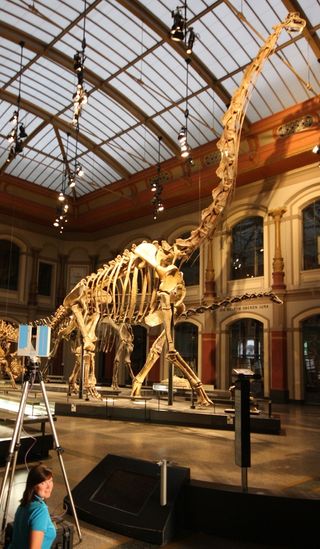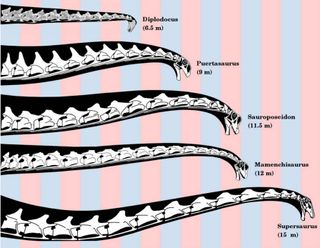How Dinosaurs Grew the World's Longest Necks

How did the largest of all dinosaurs evolve necks longer than any other creature that has ever lived? One secret: mostly hollow neck bones, researchers say.
The largest creatures to ever walk the Earth were the long-necked, long-tailed dinosaurs known as the sauropods. These vegetarians had by far the longest necks of any known animal. The dinosaurs' necks reached up to 50 feet (15 meters) in length, six times longer than that of the current world-record holder, the giraffe, and at least five times longer than those of any other animal that has lived on land.
"They were really stupidly, absurdly oversized," said researcher Michael Taylor, a vertebrate paleontologist at the University of Bristol in England. "In our feeble, modern world, we're used to thinking of elephants as big, but sauropods reached 10 times the size elephants do. They were the size of walking whales."
Amazing necks
To find out how sauropod necks could get so long, scientists analyzed other long-necked creatures and compared sauropod anatomy with that of the dinosaurs' nearest living relatives, the birds and crocodilians.
"Extinct animals — and living animals, too, for that matter — are much more amazing than we realize," Taylor told LiveScience. "Time and again, people have proposed limits to possible animal sizes, like the five-meter (16-foot) wingspan that was supposed to be the limit for flying animals. And time and again, they've been blown away. We now know of flying pterosaurs with 10-meter (33-foot) wingspans. And these extremes are achieved by a startling array of anatomical innovations." [Image Gallery: 25 Amazing Ancient Beasts]

Among living animals, adult bull giraffes have the longest necks, capable of reaching about 8 feet (2.4 m) long. No other living creature exceeds half this length. For instance, ostriches typically have necks only about 3 feet (1 m) long.
Sign up for the Live Science daily newsletter now
Get the world’s most fascinating discoveries delivered straight to your inbox.
When it comes to extinct animals, the largest land-living mammal of all time was the rhino-like creature Paraceratherium, which had a neck maybe 8.2 feet (2.5 m) long. The flying reptiles known as pterosaurs could also have surprisingly long necks, such as Arambourgiania, whose neck may have exceeded 10 feet (3 m).
The necks of the Loch Ness Monster-like marine reptiles known as plesiosaurs could reach an impressive 23 feet (7 m), probably because the water they lived in could support their weight. But these necks were still less than half the lengths of the longest-necked sauropods.
Sauropod secrets
In their study, Taylor and his colleagues found that the neck bones of sauropods possessed a number of traits that supported such long necks. For instance, air often made up 60 percent of these animals' necks, with some as light as birds' bones, making it easier to support long chains of the bones. The muscles, tendons and ligaments were also positioned around these vertebrae in a way that helped maximize leverage, making neck movements more efficient.
In addition, the dinosaurs' giant torsos and four-legged stances helped provide a stable platform for their necks. In contrast, giraffes have relatively small torsos, while ostriches have two-legged stances. [Image Gallery: Animals' Amazing Headgear]
Sauropods also had plenty of neck vertebrae, up to 19. In contrast, nearly all mammals have no more than seven, from mice to whales to giraffes, limiting how long their necks can get. (The only exceptions among mammals are sloths and aquatic mammals known as sirenians, such as manatees.)
Moreover, while pterosaur Arambourgiania had a relatively giant head with long, spear-like jaws that it likely used to help capture prey, sauropods had small, light heads that were easy to support. These dinosaurs did not chew their meals, lacking even cheeks to store food in their mouths; they merely swallowed it, letting their guts break it down.
"Sauropod heads are essentially all mouth. The jaw joint is at the very back of the skull, and they didn't have cheeks, so they came pretty close to having Pac Man-Cookie Monster flip-top heads," researcher Mathew Wedel at the Western University of Health Sciences in Pomona, Calif., told LiveScience.
"It's natural to wonder if the lack of chewing didn't, well, come back to bite them, in terms of digestive efficiency. But some recent work on digestion in large animals has shown that after about 3 days, animals have gotten all the nutrition they can from their food, regardless of particle size.
"And sauropods were so big that the food would have spent that long going through them anyway," Wedel said. "They could stop chewing entirely, with no loss of digestive efficiency."
What's a long neck good for?
Furthermore, sauropods and other dinosaurs probably could breathe like birds, drawing fresh air through their lungs continuously, instead of having to breathe out before breathing in to fill their lungs with fresh air like mammals do. This may have helped sauropods get vital oxygen down their long necks to their lungs.

"The problem of breathing through a long tube is something that's very hard for mammals to do. Just try it with a length of garden hose," Taylor said.
As to why sauropods evolved such long necks, there are currently three theories. Some of the dinosaurs may have used their long necks to feed on high leaves, like giraffes do. Others may have used their necks to graze on large swaths of vegetation by sweeping the ground side to side like geese do. This helped them make the most out of every step, which would be a big deal for such heavy creatures.
Scientists have also suggested that long necks may have been sexually attractive, therefore driving the evolution of ever-longer necks; however, Taylor and his colleagues have found no evidence this was the case.
In the future, the researchers plan to delve even deeper into the mysteries of sauropod necks. For instance, Apatosaurus, formerly known as Brontosaurus, had "really sensationally strange neck vertebrae," Taylor said. The scientists suspect the necks of Apatosaurus were used for "combat between males — fighting over women, of course."
Taylor and Wedel detailed their findings online Feb. 12 in the journal PeerJ.
Follow LiveScience on Twitter @livescience. We're also on Facebook & Google+.

